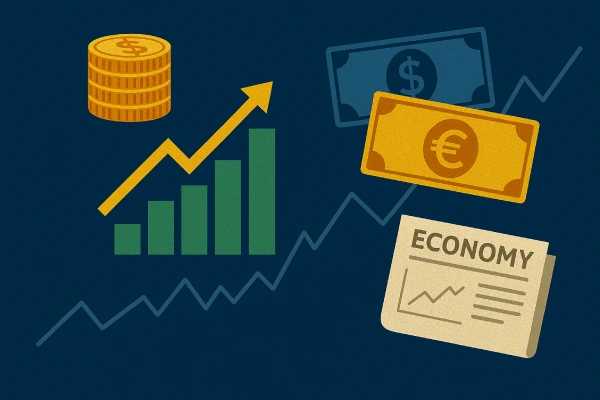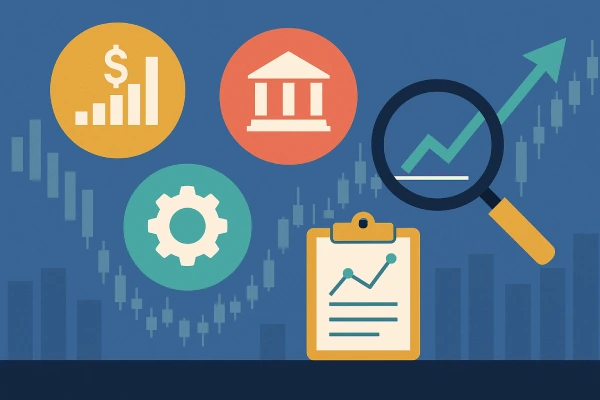Have you ever been astonished by a sudden price increase or fall in a currency pair that occurred even when there were no signals on the chart? If so, then you aren't alone! Many traders base their trading decisions solely on Forex technical analysis (trendlines, price indicators, & price patterns) and are sometimes left dumbfounded by sudden and unexpected price moves. This is because what is occurring behind the chart and what the chart is reflecting can both have very different meanings or impacts on your trading.
This is where Forex fundamentals come into play.
Suppose you identify with the emotion of uncertainty that comes with sharp price swings or want to understand the "why" behind price movements. This reading is for you! In this read, we will break down the fundamentals of Forex—what are fundamental things to know— and how you can use the fundamentals to trade.
What Are Forex Fundamentals?
Forex fundamentals include the economic, political, and financial reasons that move a currency. Forex fundamentals examine the underlying reasons for price behavior, whereas technical analysis focuses solely on price behavior.
Some of the more critical Forex fundamentals include:
Understanding forex fundamentals will help traders anticipate longer-term trends and ride the noise of short-term price swings.

Understanding Why the Fundamentals Are Important?
Because currencies reflect the state of entire economies, macro events can move market sentiment massively. Here are some examples:
If the U.S. central bank suggests it may increase interest rates, the USD may rise in value.
If there is any political unrest in the UK, the GBP may begin to fall even if its indicators are in an uptrend.
In summary:
Fundamentals will tell you what direction the market wants to move. Technicals help you time your entry.
Top Fundamental Drivers to Look For
Let us take a look at the big players in the world of forex fundamentals.
1. Interest Rates
Interest rates are likely the most potent force in the currency market. When a country raises interest rates, it attracts foreign investors looking for a better return, which increases demand for the currency.
There are a few major central banks you will want to follow:
U.S. Federal Reserve (USD)
European Central Bank (EUR)
Bank of England (GBP)
Bank of Japan (JPY)
Reserve Bank of Australia (AUD)
Bank of Canada (CAD)
Traders are vigilant for rate statements and monetary policy meetings because they hold clues as to where central banks and currencies are heading.
2. Inflation Data
Inflation measures the rate at which prices are rising. A high rate of inflation could persuade that country's central bank to raise interest rates and make that currency more attractive.
Some inflation indicators to keep an eye on are:
Consumer Price Index (CPI)
Producer Price Index (PPI)
Surprises in inflation data can produce sharp market reactions if they predict variation with Central Bank policy.

3. Employment Reports
Employment reports provide a snapshot of economic strength. A strong job market often leads to greater consumer spending, which in turn drives economic growth.
The most widely followed employment report is:
Non-Farm Payrolls (NFP) in the U.S.
If the job numbers are better than expected, the currency will often respond with moves to the upside; if they are disappointing, it can move to the downside.
4. GDP (Gross Domestic Product)
Gross Domestic Product represents the total value of all goods and services produced in an economy. It is the most comprehensive metric of economic health.
But remember that GDP is a lagging indicator; the market is far more responsive to outlooks than the number.
5. Political Event and Risk Sentiment
Politics and unforeseen global occurrences often lead to short-term volatility, or a shift in an existing longer-term trend.
Examples include:
Elections
Trade wars
Conflicts or sanctions
Leadership changes
Natural disasters
If the uncertainty rises, traders tend to shift their money into safe-haven currencies, which are the U.S. dollar (USD), Swiss franc (CHF), or Japanese yen (JPY).
Tips to Incorporate Fundamentals in Trading
You don't need a degree in economics to incorporate fundamentals successfully. Here's how to get started:
1. Use the Economic Calendar
Utilize resources like:
Forex Factory
Investing.com
Your brokers calendar
Calendars can show upcoming news, upcoming release times, forecasts, and estimated impact. Avoid events with a low impact and focus on high-impact events like rate decisions or NFP reports.
2. Get to Know Market Expectations
The markets move, not just on the news, but also on whether the expected news is better or worse than expected.
If the forecast is +200,000 jobs but +100,000 jobs were added, then the outcome, even positive, might push the currency lower.
Always compare the actual result with your expectations to get a sense of what to expect from the market.

3. Use It In Combination with Technical Analysis
The most successful traders are using a blended approach to both Fundamentals and Technicals.
For example, when you are aware that the USD has been strengthening due to rising interest rates, and that when you are analysing the EUR/USD, there is a signal on the price chart indicating a bearish breakout, your opinions are aligned. You have a high-quality setup and an excellent trading opportunity.
Common Fundamental Mistakes to Avoid
Let's go through a few traps to avoid.
1. Jumping into a Position without a Plan
Just because a headline appears to be important does not mean it is a good idea to take a trade. Keep in mind that even some high-impact news releases cause the markets to behave erratically by spurring in both directions before establishing a direction. Have a plan, or let the market settle down from the volatility in reaction to the news.
2. Trying to Overanalyze All News Data
It is impossible to stay on top of every economic indicator, just like you can't know everything before trading. Stay on top of key data that matters and be informed when it regularly occurs, typically moving the markets.
3. Not Putting Time and Effort into Historic Data
Most fundamentals will shift the medium and long-term trend direction. Don't expect that one news release will change the direction of a significant trend in hours or days.

Conclusion
The forex fundamentals are the motor of the price-moving vehicle. Technicals can show you a pattern (or structure) in the forecasting process, but the fundamentals give you the determination of why a market price is acted out as it is.
Once you can tune your recognition for what matters most (interest rates, inflation rates, and Central Bank Policy), you should find it is very easy to conservatively trade price action with more purpose and clarity—and not react unthinkingly to price fluctuations, as you will know the reason for price activity.
Start small. Pay attention to the Economic Calendar and CB language. Most importantly, pay attention to what creates the story behind each currency. Because in Forex, if you can identify the reasoning behind the "why", this tends to be the edge that most traders miss.
Would you like a portable PDF summary, infographic, or cheat sheet version of this article to keep in your trading folder? I would be happy to send you either—just let me know!





